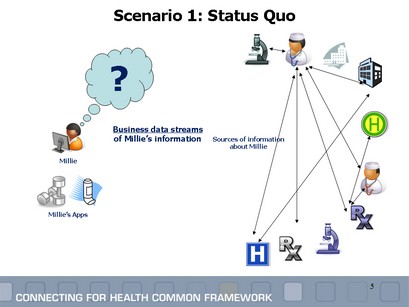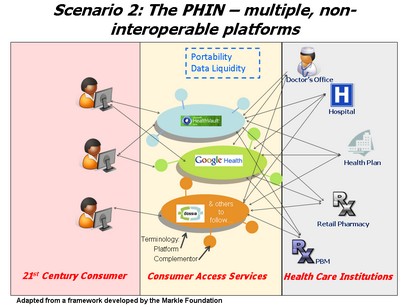Subscribe if you want to be notified of new blog posts. You will receive an email confirming your subscription.
Picturing the PHIN as One Interoperable Network
Will the Microsoft HealthVault, Google Health, and Dossia personal health information (PHI) platforms be able to exchange data? In our introductory essay announcing the Birth of the Personal Health Information Network (PHIN), Dr. David Kibbe and I posed a critical question:
What will the PHIN look like? Will there be multiple, non-interoperable, competing networks or just one interoperable network?
This question is being answered with the best possible answer: the PHIN is evolving as one, interoperable network.
Consider 3 scenarios:
-
Scenario One: Status Quo — Your Personal Health Information Today
-
Scenario Two: The PHIN — Multiple, non-interoperable platforms
-
Scenario Three: The PHIN—Multiple, interoperable platforms
In this post, I’ll present images of these scenarios as a foundation for a series of upcoming posts. David and I will address questions such as “What’s really different about the PHIN? What elements create the transformative potential that has attracted Internet Titans to health care?”
Let’s take a look at these one at a time:
Scenario 1: Status Quo — Your Personal Health Information Today
Today’s health care system is largely “closed”. Your personal health information (PHI) is
- Scattered among multiple providers and locations, and
- Not accessible using broad computer industry and Internet standards.
While a lot of your health data is already being exchanged among “business to business” (B2B) applications, consumers generally have no access to or knowledge of these information streams. Today’s situation is depicted by Scenario 1 (click on the diagrams to see a larger version).
Scenario Two: The PHIN — Multiple, non-interoperable platforms
It’s possible to think of the PHIN as multiple, non-interoperable, competing networks — an analogy might be credit card networks.
VISA, MasterCard, American Express and others each operate on separate platforms, and their networks are NOT interoperable — you can’t buy something at a store that only accepts American Express credit cards by presenting your VISA card. This is Scenario 2 as shown in the diagram below.
Scenario 2 is better than the status quo — consumers begin to have access to some of their PHI in the hands of health care institutions, but their access is limited depending on which institutions have signed up with the platform they have chosen (Google Health, HealthVault, Dossia).
It’s better, but not optimal.
Scenario Three: The PHIN—Multiple, interoperable platforms
Scenario 3 is the best case scenario, and it’s happening!!
It’s also possible to think about the PHIN as a single network — one that is interoperable at the level of exchanging core information among platforms, but competing at other levels.
The best example we can think of is the telephone network. You know that you can use your telephone to call any other person in the world — there is one worldwide telephone network. Yet, we also observe competition at many other levels — among telephone manufacturers (VTech, Nokia, Motorola), among carriers (AT&T, Verizon, Sprint), and among cellular networks (GSM and CDMA).
How do we know this is happening? Because they say it’s so.
I’ve attended several conferences in the past several months at which representatives from Google, Microsoft and Dossia have spoken.
Representatives from Microsoft speak clearly and in the loudest voices — “We are adopting open standards. We want to be interoperable with anyone and everyone”. Here’s a direct quote from Keith Toussaint of Microsoft. He’s interviewed by Amy Tenderich on the Diabetes Mine blog.
This brings to mind another issue: the need to ensure that we (all of us) work as hard as we can to ensure data interoperability among consumer-focused health platforms. We’re investing in the technology that would allow our users to exchange data with existing services from Google and Indivo (platform on which the Dossia service for employer health records was created) ensuring that the consumer remains in control of their data. We believe that, along with the focus on device connectivity and working with partners to build innovative applications, will give individuals a very powerful solution for managing their care.”
Representatives I’ve heard from Google speak the same message, but in somewhat softer voices.
Colin Evans, CEO of Dossia voices no objections to interoperability and sees the value, but is less committal as to whether Dossia will become interoperable with HealthVault and Google Health. Colin, if you’re reading please feel free to set the record straight in a comment.
If you’d like to hear the respective messages with your own ears, tune in to a webcast panel discussion I facilitated featuring Keith Toussaint from Microsoft, Neil Ramshaw from Google, and Colin Evans from Dossia. The webcast is from the recent RWJF sponsored Project Health Design Forum on Next Generation PHRs (click on Part 9 — Where is this Headed? A Technology Industry Perspective).
More thoughts about the PHIN shortly….
This work is licensed under a Creative Commons Attribution-Share Alike 3.0 Unported License. Feel free to republish this post with attribution.


